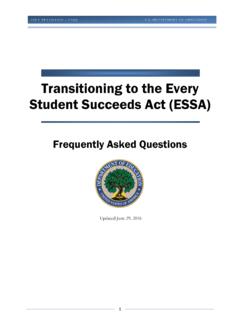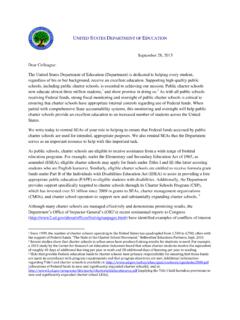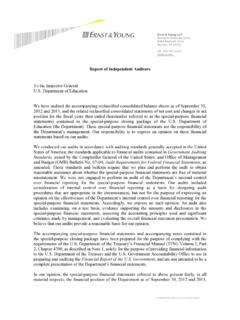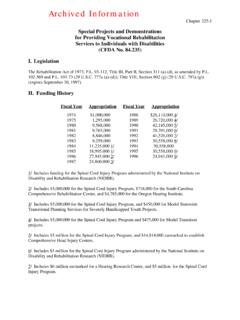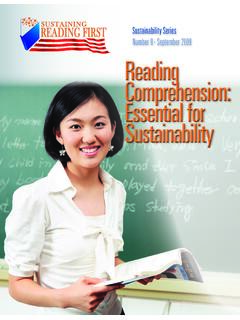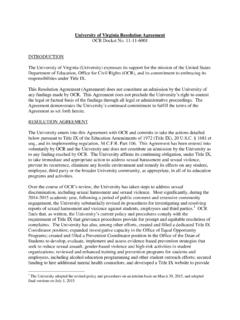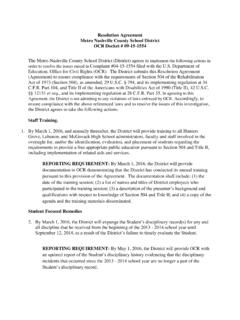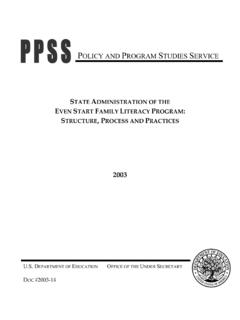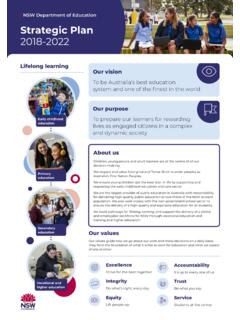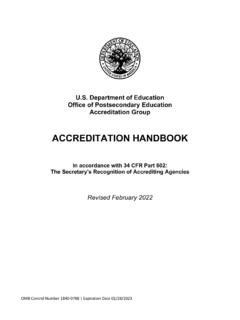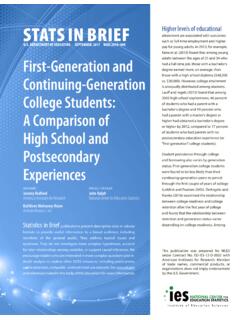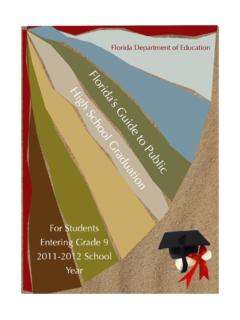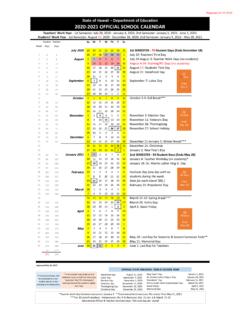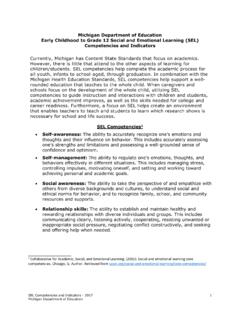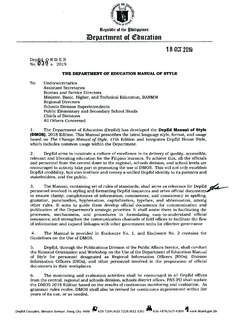Transcription of Education in a Pandemic
1 Education in a Pandemic : The Disparate Impacts of COVID-19 on America s Students OFFICE FOR CIVIL RIGHTS Message from the Acting Assistant Secretary In his Executive Order on Supporting the Reopening and Continuing Operation of Schools and Early Childhood Education Providers, President Biden expressed our nation s commitment to students across the country: Every student in America deserves a high-quality Education in a safe environment. 1 Over the course of the COVID-19 Pandemic , so many students have found new ways to continue learning in this challenging time and countless teachers, staff, faculty, administrators, and institutional leaders, along with students families, have gone above and beyond to support our students at all educational levels. Yet, this promise of a safe, high-quality Education was already out of reach for many students long before the COVID-19 Pandemic and could slip further away if we do not act collectively and with attention to equal opportunity for all students.
2 Against this backdrop, this Report responds to President Biden s Executive Order, and, specifically, to this call to the Assistant Secretary for Civil Rights in the department of Education : [T]o deliver a report as soon as practicable on the disparate impacts of COVID-19 onstudents in elementary, secondary, and higher Education , including those attendinghistorically black colleges and universities, and Tribal colleges and universities, Hispanic-serving institutions, and other minority-serving The department s Office for Civil Rights (OCR) has responsibility for enforcing laws enacted by Congress that guarantee all students access to educational opportunities free from discrimination based on race, color, national origin, sex, disability, and OCR does this by providing information to students, families, and the national community about the right to equal educational opportunity; investigating allegations of discrimination and responding to violations of the laws OCR is charged with enforcing; providing guidance for schools on their civil rights responsibilities; and collecting and analyzing civil rights data about students experiences in our nation s schools, including through the national Civil Rights Data Collection.
3 At the heart of this work is our shared commitment to equity meaning consistent and systematically fair, just, and impartial treatment for all of our nation s 1 Exec. Order No. 14000, 86 Fed. Reg. 7,215 (Jan. 26, 2021). 2 Id. at 7,216 (emphasis added). 3 These laws, enforced by OCR, prohibit discrimination in Education by all recipients of Federal financial assistance: Title VI of the Civil Rights Act of 1964, 42 2000d et seq.; 34 Part 100 (the department s regulations implementing Title VI); Title IX of the Education Amendments of 1972, 20 1681 et seq.; 34 Part 106 (the department s regulations implementing Title IX); Section 504 of the Rehabilitation Act of 1973, 29 794; 34 Part 104 (the department s regulations implementing Section 504); Age Discrimination Act, 42 6101 etseq.; Part 110 (the regulations implementing the Age Discrimination Act). Title II of the Americans withDisabilities Act of 1990, 42 12131-12134, and the department of Justice s (DOJ) regulations implementingTitle II, 28 Part 35, also prohibit discrimination in Education by state and local governments regardless of whetherthey receive Federal funds.
4 OCR is responsible for administrative enforcement of Title II of the ADA with regard toeducational institutions. For more information about Title II of the ADA, see DOJ s website. DOJ alsoenforces laws prohibiting discrimination in educational opportunities. For more information, see EducationalOpportunities Section, Civil Rights Division on the DOJ As the Biden-Harris Administration has explained,the term equity means the consistent and systematic fair, just, and impartial treatment of all individuals, including individuals who belong to underserved communities that have been denied such treatment, such as Black, Latino, and Indigenous and Native American persons, Asian Americans and Pacific Islanders and other persons of color; members of religious minorities; lesbian, gay, bisexual, transgender, and queer (LGBTQ+) i This Report bears witness to the many ways that COVID-19, with all of its tragic impacts on individuals, families, and communities, appears to be deepening divides in educational opportunity across our nation s classrooms and campuses.
5 Although the Pandemic s effects will be studied for many years to come, we know from early studies that for many students, the educational gaps that existed before the Pandemic in access, opportunities, achievement, and outcomes are widening. And we can see already that many of these impacts are falling disproportionately on students who went into the Pandemic with the greatest educational needs and fewest opportunities many of them from historically marginalized and underserved groups. These disparities can be a cause for great concern, especially when they interfere with a student s opportunity to learn, grow, and contribute to our nation s Although this Report provides a data-driven account of COVID-19 s disparate impacts on students, rather than a legal analysis, it is important to recognize that disparities can sometimes be evidence of legal injuries under Federal civil rights laws, even when policies and practices do not directly single out a group of people for harm.
6 These laws include Title VI of the Civil Rights Act of 1964, which prohibits discrimination based on race, color, and national origin, including in educational programs and activities that receive Federal financial It is also important to recognize that, even in these trying times, students, families, educators, staff, administrators and so many others in school districts, state educational agencies, institutions of higher Education , and communities across the country are immersed in the hard work of building back better to ensure equal educational opportunity for all students. The department of Education stands ready to do all we can do to help in this effort. Suzanne B. Goldberg Acting Assistant Secretary for Civil Rights department of Education June 9, 2021 persons; persons with disabilities; persons who live in rural areas; and persons otherwise adversely affected by persistent poverty or inequality. Exec. Order No.
7 13985, 86 Fed. Reg. 7009, 7009 (Jan. 20, 2021). 5 For more from OCR on disparities in resources, student experiences, and the governing law, see, , Dep t of Educ., Office for Civil Rights, Dear Colleague Letter: Resource Comparability (Oct. 1, 2014), ; cf. 34 (b)(2); Dep t of Educ, Office for Civil Rights, Racial Incidents and Harassment Against Students at Educational Institutions, 59 Fed. Reg. 11448, 11449 (Mar. 10, 1994), ; cf. 34 (b)(1)(iv).6 42 2000d et seq; 34 Part 100 (the department s regulations implementing Title VI).ii Executive Summary On January 21, 2021, President Joseph R. Biden, Jr. issued Executive Order 14000, Supporting the Reopening and Continuing Operation of Schools and Early Childhood Education Providers, to ensure that students receive a high-quality Education during the COVID-19 Pandemic , and to support the safe reopening and continued operation of schools, child care providers, Head Start programs, and institutions of higher Education .
8 7 As a part of that order, the President directed the Assistant Secretary for Civil Rights in the department of Education to deliver a report .. on the disparate impacts of COVID-19 on students in elementary, secondary, and higher Education . 8 This Report answers that call. As is well known, COVID-19 upended classrooms and campuses across the country at the same time as the Pandemic s devastating effects were being felt in our nation s economy and loss of life. In response, educators, staff, and school leaders at all educational levels and in all parts of the country have made extraordinary commitments and dedicated their talents, energy, and resources to address the needs of students and families in their communities. Parents, family members, and caregivers have done the same, supporting their students while responding to profound challenges in their own lives. Still, COVID-19 s impacts have fallen unevenly and preliminary data indicate that they appear to be deepening disparities in educational opportunity and achievement, many of them generations in the making.
9 With the Pandemic s spotlight on these longstanding challenges, we have a rare moment as a country to take stock and to begin the hard work of building our schools back better and stronger with the resolve necessary to ensure that our nation s schools are defined not by disparities but by equity and opportunity for all students. In preparing this Report, the Office for Civil Rights (OCR) reviewed an array of publicly available sources documenting the impacts of COVID-19 on America s students. Many of those sources reported findings from surveys or interviews of students, families, and educators from across the country. Additional sources supplied information about how the Pandemic has disrupted educational practice in ways that are likely to limit students learning and achievement. Unless specifically noted, the findings and information presented here are not based on research conducted by the department of Education .
10 Nor is the discussion here offered as a comprehensive survey of research in the field. To the contrary, there are countless works in progress and even more to come that will enhance our understanding over time of the Pandemic s many effects on students. It is also important to note that none of the statements in this Report is intended to set forth a legal or policy judgment under any of the statutes OCR enforces or any other source of law. Instead, this Report, like the sources it discusses, tells part of a developing story by offering a series of snapshots from mid-March 2020, when many schools shifted abruptly to remote learning, to mid-April 2021. This developing story prompts eleven observations about how widely and inequitably the Pandemic appears to have impacted America s students during this time. OBSERVATION 1 (K-12): Emerging evidence shows that the Pandemic has negatively affected academic growth, widening pre-existing disparities.

